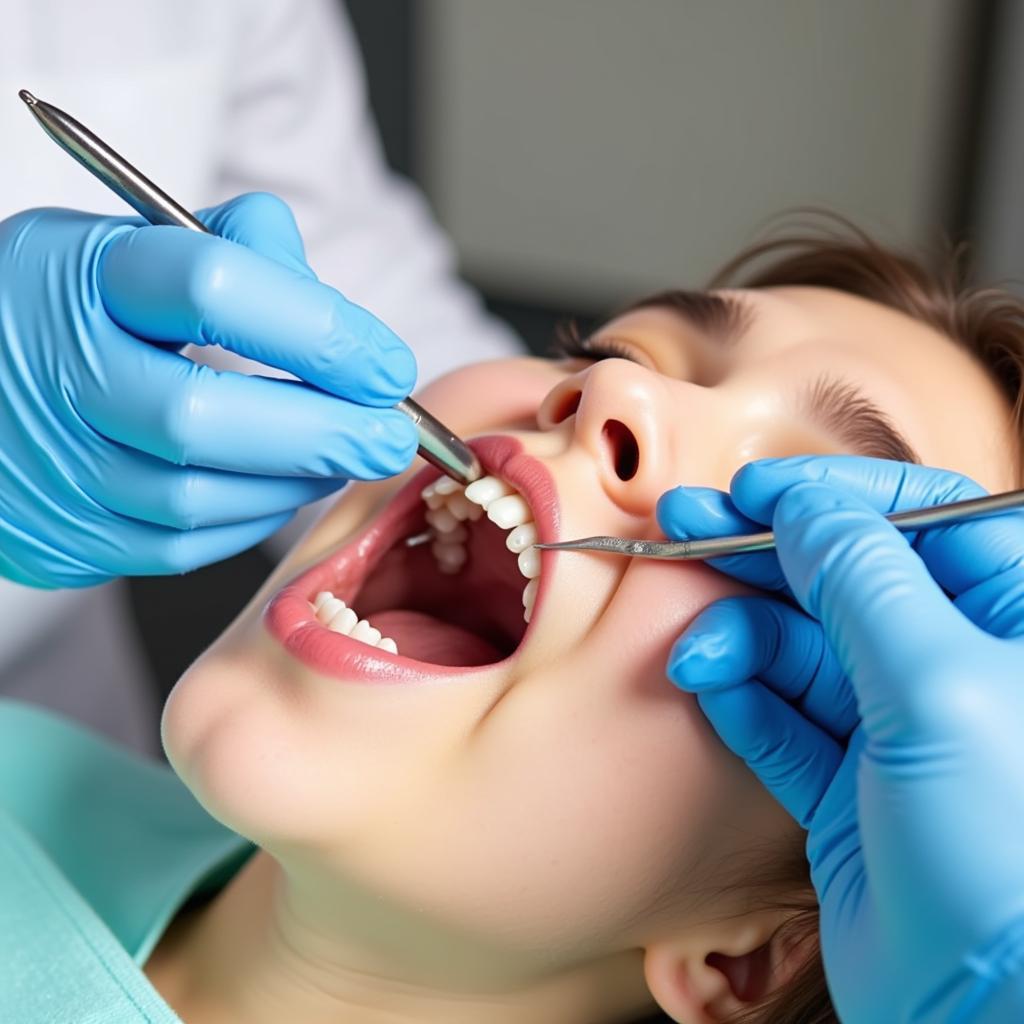Dealing with food stuck in a broken tooth can be incredibly frustrating and uncomfortable. Whether you’ve chipped a tooth or have a more serious fracture, trapped food particles can lead to pain, bad breath, and even infection. This guide will provide you with practical tips and advice on how to manage this common dental issue.
Understanding the Problem: Why Food Gets Stuck
A broken tooth creates an uneven surface, providing the perfect crevices for food to become lodged. This can range from small pieces of popcorn kernel to strands of fibrous vegetables. The problem is exacerbated by existing cavities or fillings that may have been damaged along with the tooth fracture.
“A broken tooth often exposes the inner layers of the tooth, making it more susceptible to bacteria and infection if food particles are not removed promptly,” says Dr. Emily Carter, DDS, a leading dental specialist in Chicago.
Besides the immediate discomfort, trapped food can irritate the surrounding gum tissue, leading to inflammation and bleeding. Ignoring the issue can also increase the risk of infection, potentially requiring more extensive dental treatment down the line.
 Food Stuck in Broken Tooth Close-up
Food Stuck in Broken Tooth Close-up
Effective Methods to Remove Food from a Broken Tooth
Knowing the right techniques to dislodge trapped food is crucial. While some methods are safe and effective at home, others should be avoided to prevent further damage.
Safe DIY Techniques:
- Rinsing: Gently swish warm salt water around your mouth. This can help dislodge smaller particles and soothe irritated gums. Avoid vigorous rinsing as this could worsen the situation.
- Flossing: Carefully use dental floss to remove debris around the broken tooth. Be gentle to avoid cutting your gums. Consider using a floss threader for easier access to tight spaces.
- Interdental Brushes: These small brushes are designed to clean between teeth and can be helpful in removing food from hard-to-reach areas around a broken tooth.
- Water Flosser: A water flosser uses a stream of pulsating water to remove food particles. This can be particularly effective for dislodging stubborn debris.
 Using a Water Flosser for a Broken Tooth
Using a Water Flosser for a Broken Tooth
What NOT to Do:
- Sharp objects: Avoid using toothpicks, pins, or other sharp objects to pick at the trapped food. This can further damage the tooth or gums and introduce bacteria.
- Aggressive brushing: Brushing too hard can exacerbate the problem and cause further damage to the broken tooth and surrounding gums.
When to See a Dentist
While at-home methods can be helpful, it’s essential to see a dentist as soon as possible after breaking a tooth.
Signs You Need Immediate Dental Attention:
- Severe pain
- Swelling or bleeding gums
- Signs of infection
- Inability to remove the trapped food
“Early intervention is key to preventing further complications and ensuring the best possible outcome for a broken tooth,” advises Dr. Michael Rodriguez, DMD, a renowned dental surgeon in New York. “Don’t delay seeking professional help.”
 Dentist Examining Broken Tooth
Dentist Examining Broken Tooth
Preventing Food from Getting Stuck in a Broken Tooth
Once your tooth has been treated by a dentist, preventive measures can help minimize the risk of food getting stuck again.
- Maintain good oral hygiene: Brush and floss regularly, paying special attention to the area around the repaired tooth.
- Avoid hard or sticky foods: Limit consumption of hard candies, nuts, and other foods that can easily break or chip teeth.
- Wear a mouthguard: If you grind your teeth at night, a mouthguard can protect your teeth from further damage.
- Regular dental checkups: Routine visits to your dentist can help identify and address potential problems early on.
Conclusion
Dealing with food stuck in a broken tooth requires prompt and careful action. By following the guidelines outlined in this article, you can effectively manage this common dental issue and maintain good oral health. Remember, seeking professional dental care is crucial for long-term solutions and preventing further complications. Don’t let a broken tooth and trapped food impact your overall well-being.
FAQ
- What should I do if I can’t get the food out myself? See a dentist immediately.
- Can I use mouthwash instead of saltwater rinse? Saltwater is generally preferred as it’s gentler on irritated gums.
- How long can I wait before seeing a dentist for a broken tooth? You should see a dentist as soon as possible, preferably within 24 hours.
- Will a broken tooth always need to be extracted? Not necessarily. Depending on the severity of the break, various treatment options are available.
- Is it normal to experience some sensitivity after a tooth is broken? Yes, some sensitivity is common, especially to hot or cold temperatures.
Common Scenarios
- Scenario 1: A piece of popcorn kernel gets stuck in a chipped tooth causing discomfort and sensitivity.
- Scenario 2: A large piece of meat becomes lodged in a fractured molar, leading to pain and difficulty chewing.
- Scenario 3: Food continuously gets trapped in a broken tooth, resulting in gum inflammation and bad breath.
Further Reading
- Find more information on dental emergencies on our website.
- Learn about different types of dental restorations for broken teeth.
Contact us for assistance at Phone Number: 02437655121, Email: minacones@gmail.com or visit our location: 3PGH+8R9, ĐT70A, thôn Trung, Bắc Từ Liêm, Hà Nội, Việt Nam. We have a 24/7 customer support team available to assist you.